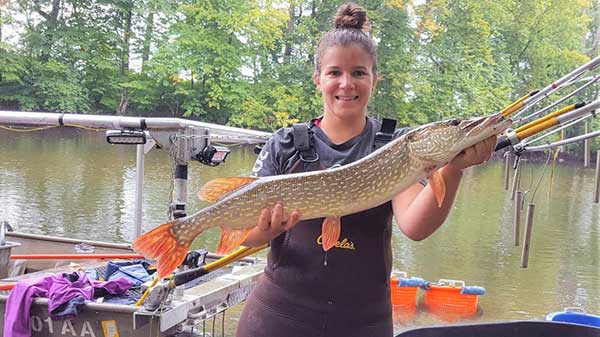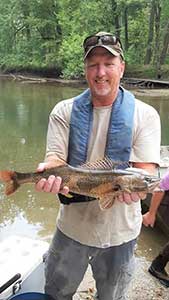By Louie Stout
 Tippecanoe River: Indiana’s Best Kept Secret for Bass, Walleye and Pike
Tippecanoe River: Indiana’s Best Kept Secret for Bass, Walleye and Pike
About 50 years ago, my good friend Al Tucker and I waded the Tippecanoe River for rock bass and smallmouth on hot summer afternoons.
We’d slide into cutoff jeans and old sneakers, walk into the water to our waist and cast tiny Rooster Tails and Mepps Spinners into the pools and eddies. We caught a lot of fish every trip.
I haven’t been back since my teenage days, so my assumption has been that urban incursion and pollution has diminished that fabulous fishery over those years.
District fisheries biologist Tom Bacula says that’s not the case.
Last fall, he led a team of fish managers through a major study of the “Tippy” from Oswego, Ind. in Kosciusko County down to Winamac, Ind. in Pulaski County.
The “Tippy” flows from Big Lake in Noble County to the Wabash River near Lafayette. It’s fed by 88 natural lakes and touches 14 counties – one of Indiana’s premier rivers.
Although Bacula didn’t see the entire river, he was impressed with the numbers and quality of fish he turned up within various sections of the river he surveyed.
“It is such a cool river,” said Bacula. “We were surprised at the number of nice fish we saw.”
The survey proved what biologists have said for years: Good habitat dictates a good fish community and the species of fish that will thrive there.
Here’s a look at what he found to be most notable:
 Tippecanoe River: Indiana’s Best Kept Secret for Bass, Walleye and PikeKosciusko County: It was a slow moving river through most of the county, so it contained largemouth bass, bluegill smallmouth, rock bass and a fair amount of minnows.
Tippecanoe River: Indiana’s Best Kept Secret for Bass, Walleye and PikeKosciusko County: It was a slow moving river through most of the county, so it contained largemouth bass, bluegill smallmouth, rock bass and a fair amount of minnows.
“It’s more like a lake than the areas farther downstream,” Bacula said. “We saw a large number of rock bass below the Oswego Dam.”
Fulton County: The river touched into the northern section north of Rochester, Ind. That stretch turned up quite a few pike, walleye and sauger.
“The river transitioned into a bigger river with a lot of boulders and logs,” Bacula said. “The biggest pike we saw was in the mid-30-inch range, the biggest walleye was around 20 inches and the largest sauger was 22 inches. At Leiters Ford, Ind., we shocked five sauger over 18 inches long. There were a lot of beautiful fish.”
 Tippecanoe River: Indiana’s Best Kept Secret for Bass, Walleye and PikeSauger are closely related to walleye and some anglers confuse the two. Sauger are more prominent in rivers and typically don’t grow as big as walleye.
Tippecanoe River: Indiana’s Best Kept Secret for Bass, Walleye and PikeSauger are closely related to walleye and some anglers confuse the two. Sauger are more prominent in rivers and typically don’t grow as big as walleye.
The Leiters Ford area also offered deeper pools and a mix of big boulders and cobble rock, which is ideal for sauger.
Pulaski County: The area around the Tippecanoe River State Park is the sweet spot for smallmouth bass, although Bacula said smallmouth were abundant in all of the stretches.
The park area got 10 feet deep or more with nice bends, more sand and trees lying in the water. Some of the shallower stretches required his teams to get out and pull their boats through the riffles.
“There were a lot of quality smallmouth in that stretch,” he said. “We got several 14-inch bass and a few up to 20 inches. A previous survey that was done there a few years ago showed it had a lot of big smallmouth and we confirmed that hasn’t changed.”
There are several boat and canoe launches located from one end of the Tippy to the other, but most areas are best suited for shallow draft boats, canoes and kayaks.
For locations of public access, visit the www.in.gov/dnr/fishwild/3591.htm and check out the interactive map that lists where to fish in Indiana.


